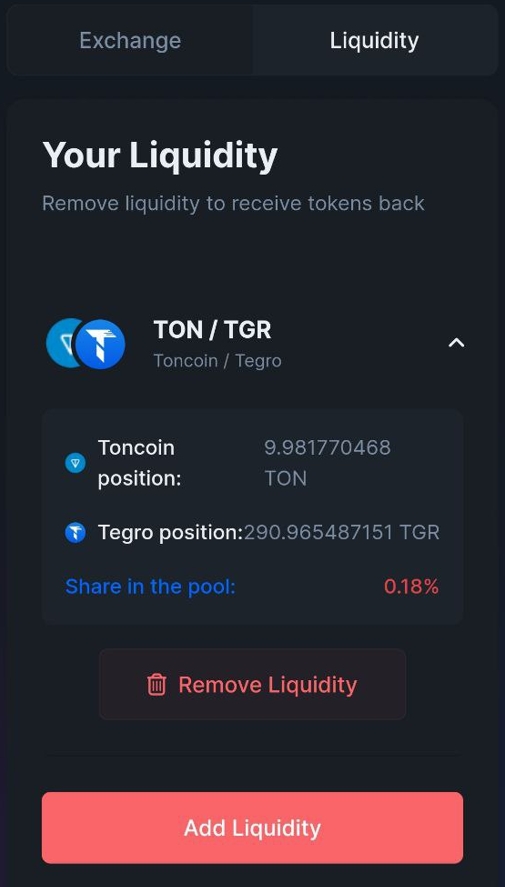💰Earnings on liquidity pools
To begin with, by adding cryptocurrency to a liquidity pool, you can earn from other people's transactions on the TON network.
To get started, go to https://tegro.finance

How to Make Money from Liquidity Pools
A liquidity pool is a "reservoir" of cryptocurrencies in pairs. A user who buys for TON, for example, TGR, is given TGR tokens from a liquidity pair, and his TON coins are sent to the pool in return.
Liquidity providers are people who provide liquidity to pools, for which they receive a percentage of the commissions spent on exchanges in a particular pair. The interest is credited in the cryptocurrencies of the trading pair, in our case - TGR and TON.
To become a liquidity provider, you need to create an LP-pair (liquidity pair) at DEX Tegro.Finance in a 50%/50% ratio, for example, TGR-TON pair.
After that, you will be sent a liquidity token to your TON-wallet, which is a confirmation that you are a liquidity provider. This token can be exchanged back into your cryptocurrency at any time.
What are Impermanent Losses
Impermanent Loss can occur because of volatility and change in the value of one cryptocurrency in relation to the value at which it was bought.
Example: if TON coin rate goes up by 50%, then in LP-pair the cryptocurrency TGR will decrease by 50%.
Pay attention to token rates, sometimes it is more profitable to keep cryptocurrency rather than add it to the liquidity pool.
Creating a liquidity pair from TGR and TON cryptocurrencies
You can learn how to buy TGR tokens in this article.
Go to DEX Tegro.Finance and click "Connect Wallet";

Next, choose a TON-wallet, which we will use to connect. In our case it is Tonkeeper, but you can use any other one;

Now open the tab "Liquidity" and select the amount of TON and TGR, which should be sent to the liquidity pool (in the column TGR automatically selected the required amount). Then click "Add Liquidity";

To start earning tokens in the TON network, you need to have TGR and TON cryptocurrencies on your TON wallet balance at a 50%/50% ratio.
Click "Confirm offer";

You will have to wait for a few seconds;

Click "Confirm";

The TON/TGR liquidity pair was successfully created;

Congratulations, your liquidity pair has been created, and you will make a profit on transactions!
Last updated